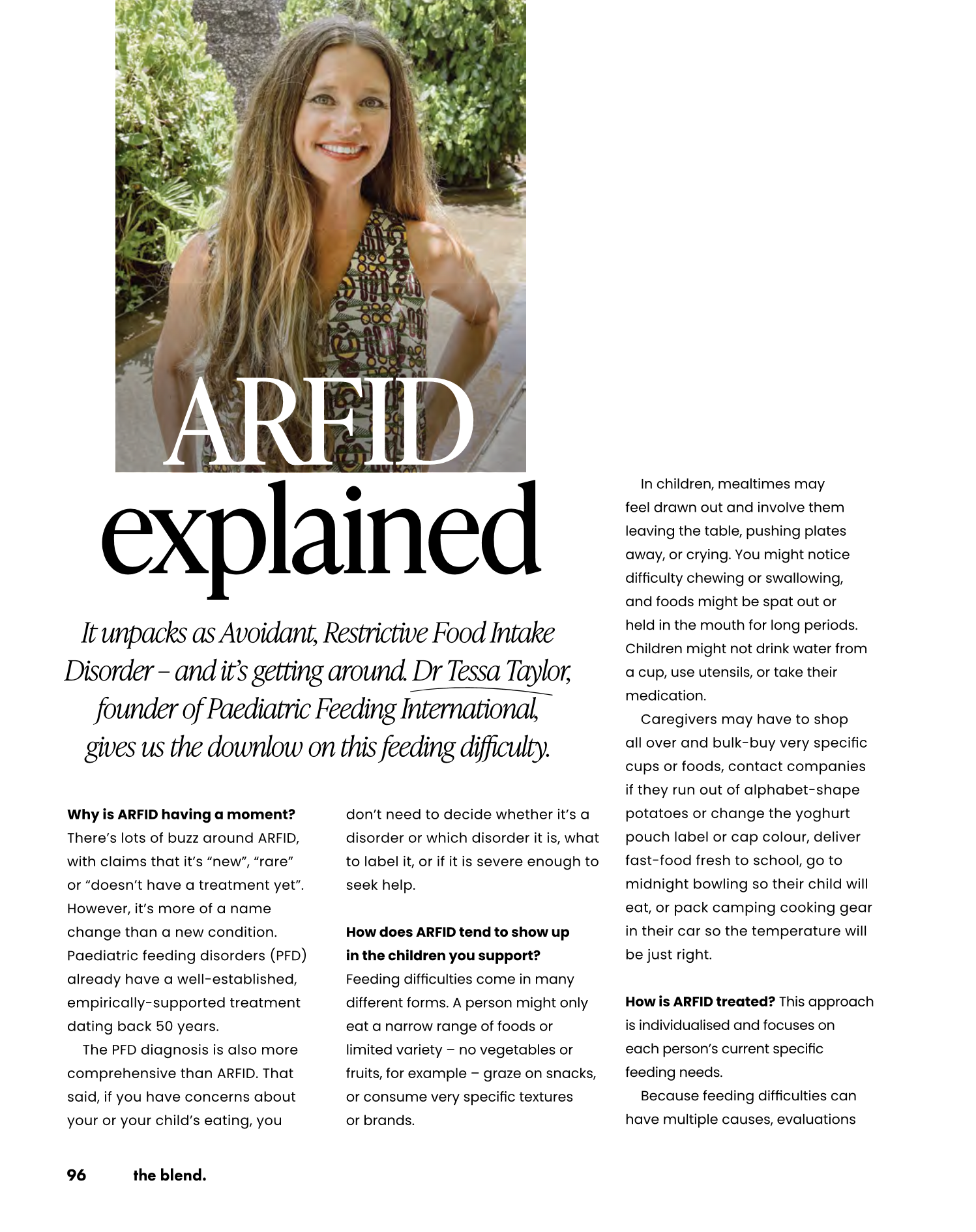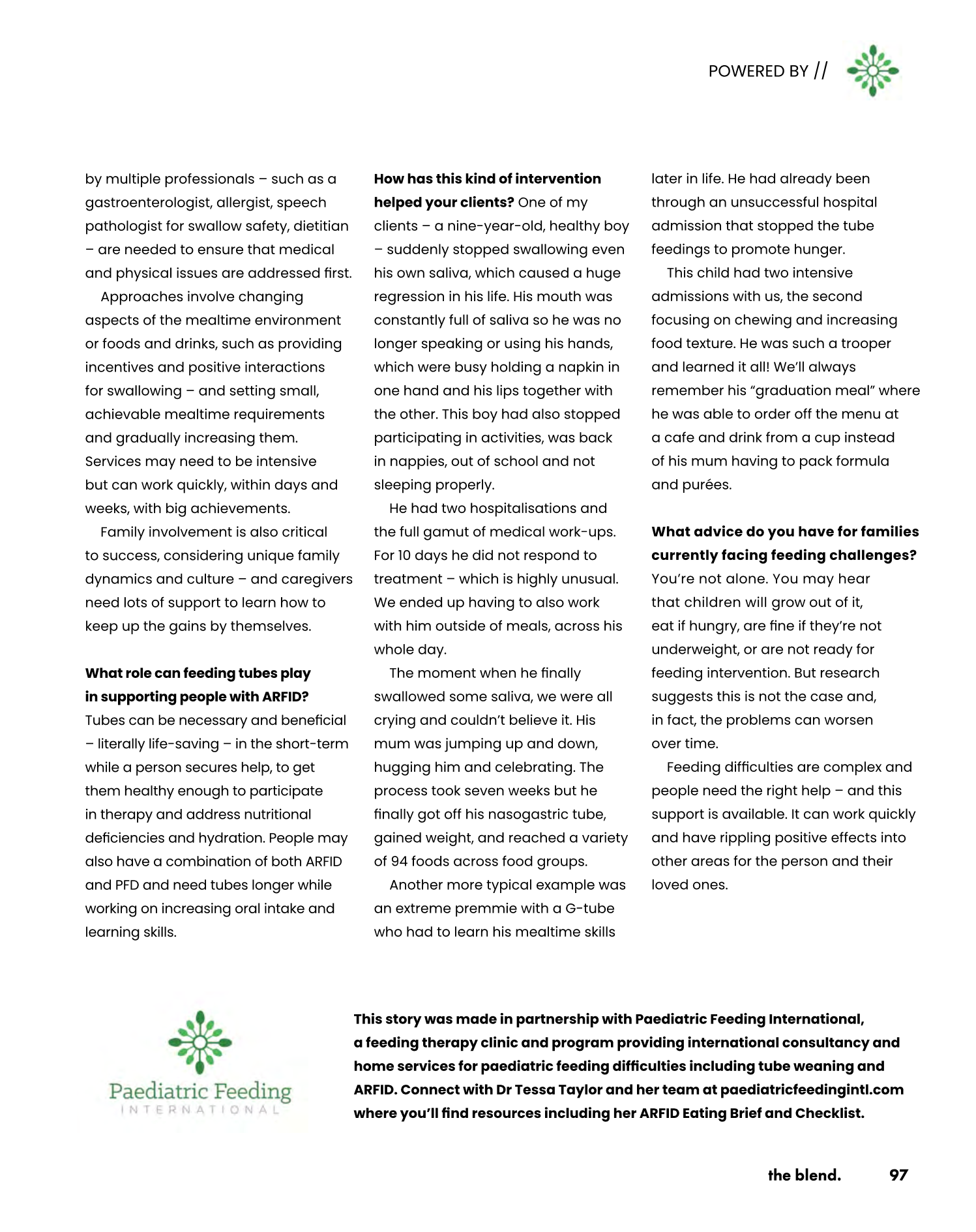Big thanks🙏 to Melanie Dimmitt for letting us be a small part of this gorgeous resource on tube feeding!
🔥🐝 Why is ARFID having a moment?
👶🍝 How does ARFID tend to show up in the children you support?
🏥📈How is ARFID treated?
👩⚕️🩺 What role can feeding tubes play in supporting people with ARFID?
🙌🤝 How has this kind of intervention helped your clients?
👪💡 What advice do you have for families currently facing feeding challenges?
Taylor, T. (2025). ARFID explained: It unpacks as Avoidant Restrictive Food Intake Disorder—and it’s getting around. Dr. Tessa Taylor, founder of Pediatric Feeding International, gives us the downlow on this feeding difficulty. In M. Dimmitt (Ed.) The Blend, 4, pg. 96.
https://www.theblendmag.com/professional-perspectives/arfid-explained
It unpacks as Avoidant, Restrictive Food Intake Disorder – and it’s getting around. Dr Tessa Taylor, founder of Pediatric Feeding International , gives us the down-low on this feeding difficulty.
Why is ARFID having a moment?
There’s lots of buzz around ARFID, with claims that it’s “new”, “rare” or “doesn’t have a treatment yet”. However, it’s more of a name change than a new condition.
Pediatric feeding disorders (PFD) already have a well-established, empirically-supported treatment dating back 50 years.
The PFD diagnosis is also more comprehensive than ARFID. That said, if you have concerns about your or your child’s eating, you don’t need to decide whether it’s a disorder or which disorder it is, what to label it, or if it is severe enough to seek help.
How does ARFID tend to show up in the children you support?
Feeding difficulties come in many different ways. A person might only eat a narrow range of foods or limited variety – no vegetables or fruits, for example – graze on snacks, or consume very specific textures or brands.
In children, mealtimes may feel drawn out and involve them leaving the table, pushing plates away, or crying. You might notice difficulty chewing or swallowing, and foods might be spat out or held in the mouth for long periods. Children might not drink water from a cup, use utensils, or take their medication.
Caregivers may have to shop all over and bulk-buy very specific cups or foods, contact companies if they run out of alphabet-shape potatoes or change the yogurt pouch label or cap color, deliver fast-food fresh to school, go to midnight bowling so their child will eat, or pack camping cooking gear in their car so the temperature will be just right.
How is ARFID treated?
This approach is individualized and focuses on each person’s current specific feeding needs. Because feeding difficulties can have multiple causes, evaluations by multiple professionals – such as a gastroenterologist, allergist, speech pathologist for swallow safety, dietitian – are needed to ensure that medical and physical issues are addressed first.
Approaches involve changing aspects of the mealtime environment or foods and drinks, such as providing incentives and positive interactions for swallowing – and setting small, achievable mealtime requirements and gradually increasing them.
Services may need to be intensive but can work quickly, within days and weeks, with big achievements. Family is also critical to success, considering unique family dynamics and culture – and caregivers need lots of support to learn how to keep up the involvement gained by themselves.
What role can feeding tubes play in supporting people with ARFID?
Tubes can be necessary and beneficial – literally life-saving – in the short-term while a person secures help, to get them healthy enough to participate in therapy and address nutritional deficiencies and hydration. People may also have a combination of both ARFID and PFD and need tubes longer while working on increasing oral intake and learning skills.
How has this kind of intervention helped your clients?
One of my clients – a nine-year-old, healthy boy – suddenly stopped swallowing even his own saliva, which caused a huge regression in his life. His mouth was constantly full of saliva so he was no longer speaking or using his hands, which were busy holding a napkin in one hand and his lips together with the other. This boy had also stopped participating in activities, was back in nappies, out of school and not sleeping properly.
He had two hospitalizations and the full range of medical work-ups. For 10 days he did not respond to treatment – which is highly unusual. We ended up having to also work with him outside of meals, across his whole day.
The moment when he finally swallowed some saliva, we were all crying and couldn’t believe it. His mum was jumping up and down, hugging him and celebrating. The process took seven weeks but he finally got off his nasogastric tube, gained weight, and reached a variety of 94 foods across food groups.
Another more typical example was an extreme prize with a G-tube who had to learn his mealtime skills later in life. He had already been through an unsuccessful hospital admission that stopped the tube feedings to promote hunger.
This child had two intensive admissions with us, the second focusing on chewing and increasing food texture. He was such a soldier and learned it all! We’ll always remember his “graduation meal” where he was able to order off the menu at a coffee and drink from a cup instead of his mother having to pack formula and purées.
What advice do you have for families currently facing feeding challenges?
You’re not alone. You may hear that children will grow out of it, eat if hungry, are fine if they’re not underweight, or are not ready for feeding intervention. But research suggests this is not the case and, in fact, the problems can worsen over time.
Feeding difficulties are complex and people need the right help – and this support is available. It can work quickly and have rippling positive effects into other areas for the person and their loved ones.
This story was made in partnership with Pediatric Feeding International, a feeding therapy clinic and program providing international consultation and home services for pediatric feeding difficulties including tube weaning and ARFID. Connect with Dr Tessa Taylor and her team via their website , where you’ll find resources including her ARFID Eating Brief and Checklist.






